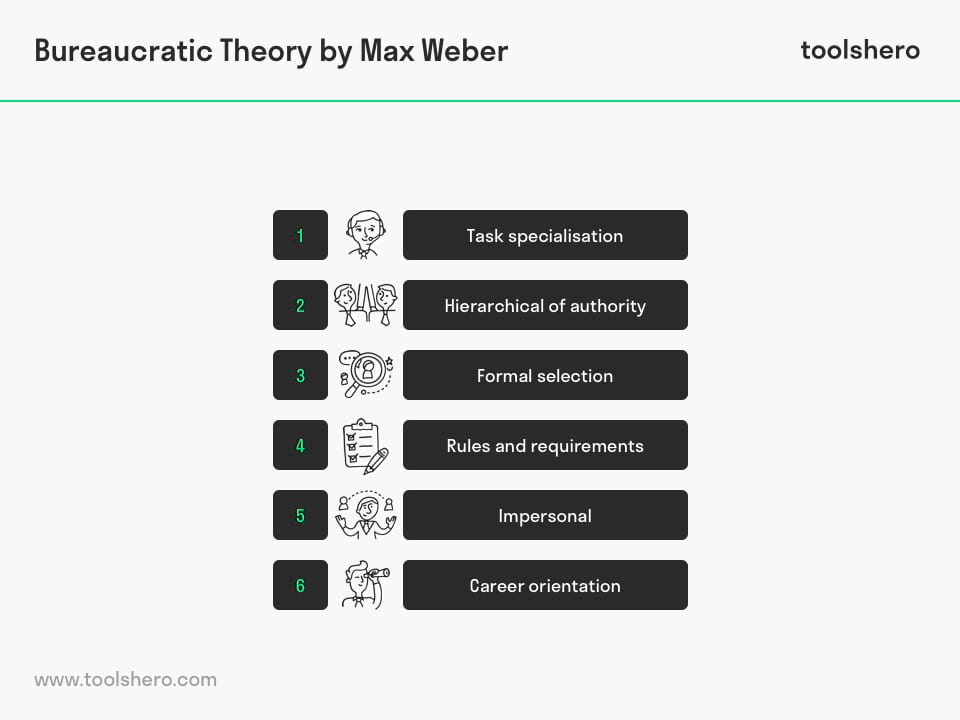Bureaucratic Theory of Management by Max Weber

Bureaucratic Theory: this article explains the bureaucratic theory of the management principles by Max Weber in a practical way. This article highlights the definition of what is bureaucracy, the characteristics, the advantages and disadvantages. After reading you will understand the basics of bureaucratic management and you can use this as a powerful scientific management theory. Enjoy reading!
What is Max Weber Bureaucracy theory?
At the end of the 19th century, it was German sociologist and author of The Protestant Ethic and the Spirit of Capitalism (1905), Max Weber, also famous of the Social Action Theory who was the first to use and describe the term bureaucracy. This is also known as the bureaucratic theory of management, bureaucratic management theory or the Max Weber theory.
He believed bureaucracy was the most efficient way to set up an organisation, administration and organizations. Max Weber believed that Bureaucracy was better than traditional structures.
In a bureaucratic organization, everyone is treated equal and the division of labour is clearly described for each employee.
Definition: what is bureaucracy:
Bureaucracy definition: “Bureaucracy is an organisational structure that is characterised by many rules, standardised processes, procedures and requirements, number of desks, meticulous division of labour and responsibility, clear hierarchies and professional, almost impersonal interactions between employees”.
According to the bureaucratic Max Weber theory, such a structure was indispensable in large organizations in structurally performing all tasks by a great number of employees.
In addition, in a bureaucratic organisation, selection and promotion only occur on the basis of technical qualifications.
Bureaucratic Theory and legal responsibility
According to the Max Weber theory, three types of power can be found in organizations; traditional power, charismatic power and legal power. He refers in his bureaucratic theory to the latter as a bureaucracy.
All aspects of a democracy are organised on the basis of rules and laws, making the principle of established jurisdiction prevail.
The following three elements support bureaucratic management:
- All regular activities within a bureaucracy can be regarded as official duties;
- Management has the authority to impose rules;
- Rules can easily be respected on the basis of established methods.
What is a bureaucratic organization?
According to this theory of Max Weber, bureaucracy is the basis for the systematic formation of any organisation and is designed to ensure efficiency and economic effectiveness.
It is an ideal model for management and its administration to bring an organisation’s power structure into focus. With these observations, he lays down the basic principles of bureaucracy and emphasises the division of labour, hierarchy, rules and impersonal relationships.
Generally, one can identify a bureaucratic organization based on its regulations.
A bureaucratic organization relies on the use of policies, rules and a strict hierarchy. Additionally, one can see an enforced chain of command and regulated operating procedures in a bureaucratic organization.
Bureaucratic Theory: the Max Weber’s six characteristics
The Max Weber theory for bureaucratic management points to six principles or characteristics. Below is a more detailed explanation of the bureaucratic management principles.
The 6 bureaucracy characteristics are:
- Task specialisation (Specialization and Division of Labor)
- Hierarchical layers of authority
- Formal selection
- Rules and requirements
- Impersonal (Impersonality and Personal Indifference)
- Career orientation

Figure 1 – 6 management principles of bureaucracy (Weber)
1. Task specialisation
Tasks are divided into simple, routine categories on the basis of competencies and functional specialisations.
Every employee is responsible for what he/she does best and knows exactly what is expected of him / her. By dividing work on the basis of specialisation, the organisation directly benefits. Each department has specific powers.
As a result, there is a delineation of tasks and managers can approach their employees more easily when they do not stick to their tasks. Every employee knows exactly what is expected of him/ her and what his/ her powers are within the organisation.
Every employee has a specific place within the organisation and is expected to solely focus on his/ her area of expertise. Going beyond your responsibilities and taking on tasks of colleagues is not permitted within a bureaucracy.
2. Hierarchical layers of authority
Managers are organised into hierarchical layers, where each layer of management is responsible for its staff and overall performance.
In bureaucratic organizational structures, there are many hierarchical positions. This is essentially the trademark and foundation of a bureaucracy.
The hierarchy of authority is a system in which different positions are related in order of precedence and in which the highest rank on the ladder has the greatest power. The bottom layers of bureaucratic organizational structures are always subject to supervision and control of higher layers.
This hierarchy reflects lines of bureaucratic communication and the degree of delegation and clearly lays out how powers and responsibilities are divided.
3. Formal selection
All employees are selected on the basis of technical skills and competences, which have been acquired through training, education and experience.
One of the basic principles is that employees are paid for their services and that level of their salary is dependent on their position. Their contract terms are determined by organisational rules and requirements and the employee has no ownership interest in the company.
4. Rules and requirements
Formal rules and requirements are required to ensure uniformity, so that employees know exactly what is expected of them. In this sense, the rules and requirements can be considered predictable.
All administrative processes are defined in the official rules. By enforcing strict rules, the organisation can more easily achieve uniformity and all employee efforts can be better coordinated. The rules and requirements are more or less stable and always formalised in so-called official reports.
Should new rules and requirements be introduced, then senior management or directors are responsible for this.
5. Impersonal
Regulations and clear requirements create distant and impersonal relationships between employees, with the additional advantage of preventing nepotism or involvement from outsiders or politics. These impersonal relationship are a prominent feature of bureaucracies.
Interpersonal relationships are solely characterised by a system of public law and rules and requirements. Official views are free from any personal involvement, emotions and feelings. Decisions are solely made on the basis of rational factors, rather than personal factors.
6. Career orientation
Employees of a bureaucratic organisation are selected on the basis of their expertise. This helps in the deployment of the right people in the right positions and thereby optimally utilising human capital.
In a bureaucracy, it is possible to build a career on the basis of experience and expertise. As a result, it offers lifetime employment.
The right division of labour within a bureaucratic organisation also allows employees to specialise themselves further, so that they may become experts in their own field and significantly improve their performance.
Up the Organization: Systems, Design & Change Management
Advantages and disadvantages of the Bureaucratic Theory
Advantages of the Bureaucratic Theory
Generally speaking, the term bureaucracy has a negative connotation and is often linked to government agencies and large organisations.
Nevertheless, the great benefit of a bureaucracy is that large organisations with many hierarchical layers can become structured and work effectively. It is precisely the established rules and procedures that allow for high efficiency and consistent execution of work by all employees.
All this makes it easier for management to maintain control and make adjustments when necessary. Bureaucracy is especially inevitable in organisations where legislation plays an important role in delivering a consistent output. For these organisations the Weber theory provides a solid framework.
Disadvantages of the Bureaucratic Theory
Bureaucracy is characterised by a large amount of red tape, paperwork, many desks, certain office culture and slow bureaucratic communication due to its many hierarchical layers.
This is the Weber theory’s biggest disadvantage of a bureaucratic organization. It is also unfortunate that employees remain fairly distanced from each other and the organisation, making them less loyal.
Bureaucracy is also heavily dependent on regulatory and policy compliance.
This restricts employees to come up with innovative ideas, making them feel like a number instead of an individual. Later research (the human relations theory) demonstrated that employees appreciate attention and want to have a voice in decision-making. This is something that the Weber theory does not consider.
Bureaucratic Theory: problems
Because employees of a bureaucratic organization have no opportunity to voice their opinion or influence decision-making, a bureaucracy may demotivate employees in the long run.
Moreover, over the course of time, employees may start to get annoyed at the various rules and requirements, with the risk that they may start boycotting and / or abusing these rules and stand up to the established order.
It is therefore very important that bureaucratic organisations properly inform employees well in advance about their approach to work and requires them to accept this. Only employees who agree to this approach are suitable to work within a bureaucratic organisation.
It’s Your Turn
What do you think? Is the bureaucratic theory of Max Weber still applicable in today’s modern organizations? Do these management principles and business ethics work in every organisation or are there exceptions? And if so, what are the exceptions and what can we learn from them?
Share your experience and knowledge in the comments box below.
More information
- Katz, D. & Kahn, R. L. (1978). The social psychology of organizations. Wiley.
- Udy Jr, S. H. (1959). Bureaucracy and Rationality in Weber’s Organization Theory: An Empirical Study. American Sociological Review, 791-795.
- Weber, M. (1978). Economy and society: An outline of interpretive sociology. Univ of California Press.
- Weber, M. (1905). The Protestant Ethic and the Spirit of Capitalism. Courier Corporation.
How to cite this article:
Mulder, P. (2017). Bureaucratic Theory (Weber). Retrieved [insert date] from Toolshero: https://www.toolshero.com/management/bureaucratic-theory-weber/
Original publication date: 06/16/217 | Last update: 04/10/2024
Add a link to this page on your website:
<a href=”https://www.toolshero.com/management/bureaucratic-theory-weber/”>Toolshero: Bureaucratic Theory (Weber)</a>













35 responses to “Bureaucratic Theory of Management by Max Weber”
It is a helpful summary of the content but it is more relevant to readers that just want to get a brief idea of the concept. For example you are not combining the contingency theory with bureaucracy which is essential as bureaucratic forms of management differ accordingly to the existing organizational situation and its currently relationship with its external and internal environment. I am just saying that you could elaborate a bit more and emphasize those fundamental concepts to fulfill someones expectations when he wants to know something more about this content. However good job!
This article was very helpful.
Thank you for your feedback Waisale. I am glad that you found the article helpful.
This article has been helpful to my studies. Thank you so much.
Thank you for your comment, Brenda.
Your article is very useful
yeah.. I love the article personally. Otherwise bureaucracy seems a better way and efficient method to run an organization. I had an exam sheet on theories of management tomorrow and for now, am good. Just after reading the article above, to me its more of just helpful.
yeah, great as it summarizes the whole theory and reading it makes you fully aware of the meaning and other aspects
Was very helpful… especially I blended it wit what I’ve already have in my handout.. and it was very great… ????
Thank you for your comment, Wayne.
The summary Article was helpful. Thank you.
Thank you for your comment, Maya.
This article is very useful to get the ideas about bureaucracy. thank you
This article is very helpful. Thank you.
The article is very helpful. My exams is coming up next week. My texts are not elaborating enough but with this article, I have been able to understand more of bureaucracy. Thank you.
Thank you for your comment, Atoki.
i like this because help my understand on this theory
A good summery for foundation
The article, is very value-leading and will give in-depth knowledge and understanding to its readers on how they should operate in an establishment hence, not flouting on administrative ethos of the organisation in which they work.
Thank you for your comment, Christian.
now i get to understand what is bureaucracy thanks alot it has realy helped
Comment: its very helpful indeed, but my question here is what differentiate bureaucratic theory and scientific theory and their similarities. thank you
Thank you for your comment, Saad.
This article is introduced to help so many in academic and beyond and it is highly commendable.
As a lecturer of Theories of Public Administration, you summarised this theory and unpacked the principles in a very simplest manner. It is easy for me to align some of them (principles) to what is currently happening in our public sector.
Thank you for your comment, Salphinah
This article has helped me a lot to understand the theory. I was not yet there but now I’m sure that I can seat for my exam of Comparative Public Administration
Thank you for your comment, Suip.
Its really helpful…. Thanks for making this great…
thank you
it was very helpful
Thank You very much.This Article was very helpful for my studies.
This article is great it has helped me to understand more ,
The article is very helpful.my exam is coming soon.I have been able to understand more about bureaucracy.Thank you very much
Can you please throw some light on Bureaucratic decision making?
Thanks u very much u help me in my assignment